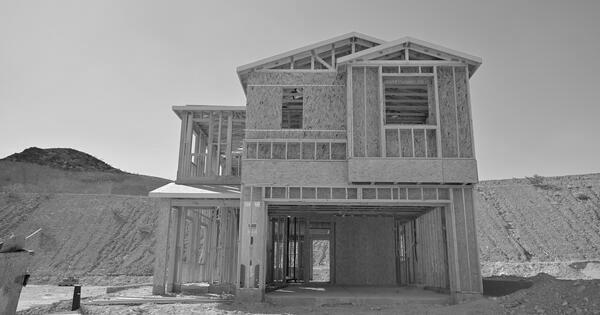
Nearly a century ago, economist and Maryland congressman Clarence Long called the building industry “probably the most strategic single factor in making or breaking booms and depressions.” Since then, economists have tried to tease apart the complex relationship between housing markets and the economy.
Building permits give you a nice signal of investors’ beliefs about the local economy. It’s a connection between Main Street and Wall Street.
A flurry of activity in housing often precedes economic downturns, from the Roaring ’20s through the 2008 Global Financial Crisis, points out Cameron LaPoint, an assistant professor of finance at Yale SOM. Real estate prices and sales volume also frequently reach a climax a few months before the stock market peaks in economic expansions. But, despite these links, understanding of the relationship has been hampered by a lack of comprehensive, long-run data on local housing market activity. LaPoint set out to solve that problem, for himself and his fellow economists.
In a new paper, LaPoint and co-author Gustavo Cortes of the University of Florida dig into the links between local housing markets and financial conditions by zeroing in on residential building permits. These permits are important to study, the researchers say, since they reflect the option for a developer to build at a later date. For the study, LaPoint and Cortes constructed a brand-new dataset of U.S. historical local building permits across all 50 states and 60 major cities from 1919 to 2019. They found that periods of rapid increases in building permits followed by quick declines predict subsequent booms and busts in both stock and bond markets.
“Building permits give you a nice signal of investors’ beliefs about the local economy,” LaPoint says. “They reflect one’s thinking that having the option to build is valuable.” Across 100 years of data and 20 recessionary periods, these movements in local building permit activity consistently predict fluctuations in stock and bond markets. “It’s a connection between Main Street and Wall Street,” he says.
To build their dataset, the researchers spent two years hand-collecting and digitizing data with the help of deep-learning optical character recognition techniques. They pulled historical building permit data from 1919 to 1957 from business publication Dun’s Statistical Review, tweaking scanning software settings so it could accurately read yellowing, vintage periodical pages. To fix inevitable scanning errors, they wrote custom code in Excel. “There’s a lot of trial and error in this process,” LaPoint says.
For permits from 1960 to 1987, the researchers pulled figures from the U.S. Census Bureau’s Building Permit Survey (BPS), which includes paper reports from city and county clerks on numbers of approved permits. The researchers focused on single-family home permits, since builders and developers tend to execute on them with a higher degree of probability, says LaPoint. “They’re a more precise signal of investors activity,” he says.
Inevitably, reports had gone missing. So the researchers turned to HathiTrust Digital Library, a nonprofit collaborative of libraries that preserves millions of digitized items, to find books with the missing data. Two years ago over Thanksgiving, LaPoint spent hours at his childhood desk, clicking on digitized books and waiting for thousands of pages to download. The researchers also tracked down figures through the Federal Depository Library Program, a government program that collects and organizes federal data. For data from 1988 to 2023, they downloaded permit numbers from the U.S. Census Bureau website.
Then LaPoint and Cortes compared fluctuations in permits to stock and bond market volatility, measured by daily returns. Their hypothesis about permits’ predictive power held true for historical periods when mortgage credit was scarce, as well as in the modern day, when credit is more plentiful.
Building permit activity was predictably more volatile in cities and states in the southern U.S. that have more elastic housing supply—that is, places where developers have more flexibility to build when demand rises and pull back when it falls. Often in these places, land is more available, and regulations aren’t as strict; Atlanta, for example, is more elastic than San Francisco.
LaPoint and Cortes found that when building permit activity in Florida became 10% more volatile, stock market volatility increased by 0.2 percentage points and bond market volatility by 0.7 percentage points a year later. This predictive power wasn’t found in heavily regulated states like Connecticut. “Places like Florida have been more lax in terms of their regulatory constraints on new housing,” says LaPoint.
In the data, they could see that in the years leading up the Great Depression, total permits issued in Miami peaked at $65.7 million in 1925 during a Florida land boom facilitated by railroad expansion, then plummeted to $1.2 million on the eve of the 1928 Okeechobee Hurricane. Building permits in Florida also peaked five months before the 1973 OPEC recession; another peak led the Great Recession of 2007–2009 by almost two years. Las Vegas, another city with an elastic housing supply, also saw downturns in 2006.
From 1989 on, the researchers were also able to examine the connection between local permit activity and movements in individual companies’ stock prices, including Coca-Cola and Home Depot. Based on companies’ plant locations, they calculated how exposed businesses were to swings in permit activity. They found that companies with operations in areas experiencing volatile building permit activity saw more volatility in their own stock prices. “It’s like the local real estate market’s jitters spread to businesses operating in that area,” LaPoint says.
The connection implies that investors could use increases in building permits to design trading strategies that hedge against firms’ exposure to real estate markets facing a glut of new residential development, says LaPoint. “It suggests firms are exposed differentially to overbuilding, and that building permits can almost operate as a risk factor for firms included in the S&P 500.”
Currently, LaPoint and Cortes are working to fill a gap in their dataset from 1957 to 1959, when Dun’s stopped publishing, and before the U.S. Census Bureau took over data collection. When their dataset is complete, they plan to post raw data online. In the meantime, they’re building a website that will feature interactive graphs with key data.
The research has far-reaching implications, LaPoint says, for investors, housing policy, and even the housing affordability crisis. Today, permits-to-population ratios are at historic lows in high-regulation states, particularly in New England. Data patterns might help consumers predict when prices could peak so they could gauge the best time to buy.
“Looking at these 100 years of data, it’s worth thinking about, how do we go back to where we can meet the demand of the population, if the supply we have now is really weak compared to the past. We’re trying to translate our measure of building permits into a more direct measure of housing supply over time.” Future research could predict stock returns, too, he says, giving investors another forecasting tool.
For financial regulators, volatile building permit activity in certain regions, and particularly in the South, could serve as an early warning for broader financial market instability. “This could help regulators identify when and where to focus attention to curb potential developer enthusiasm and overbuilding risks,” says LaPoint.
“The Yale School of Management is the graduate business school of Yale University, a private research university in New Haven, Connecticut.”
Please visit the firm link to site


